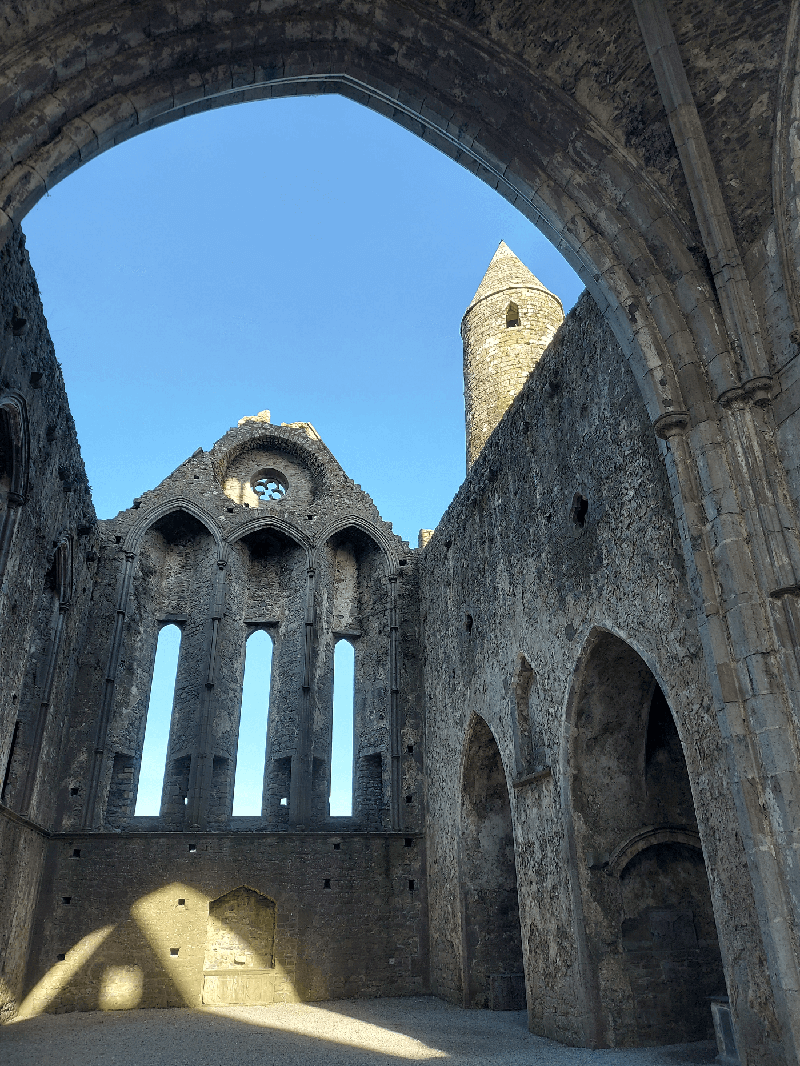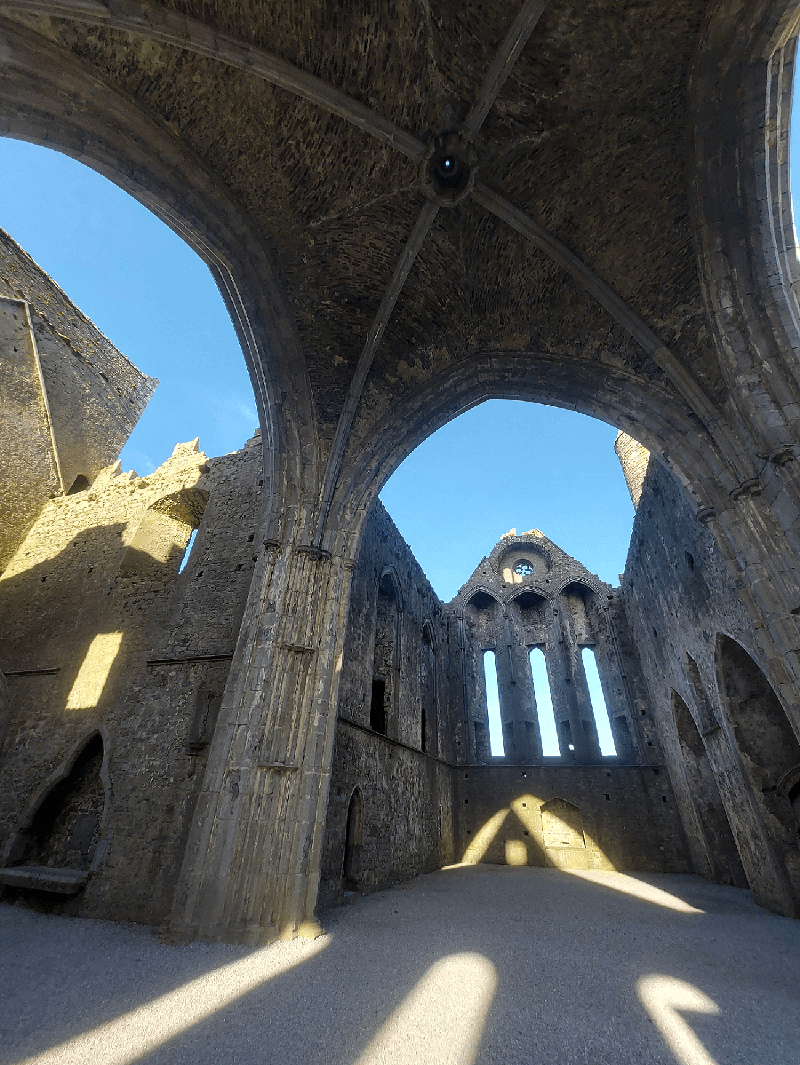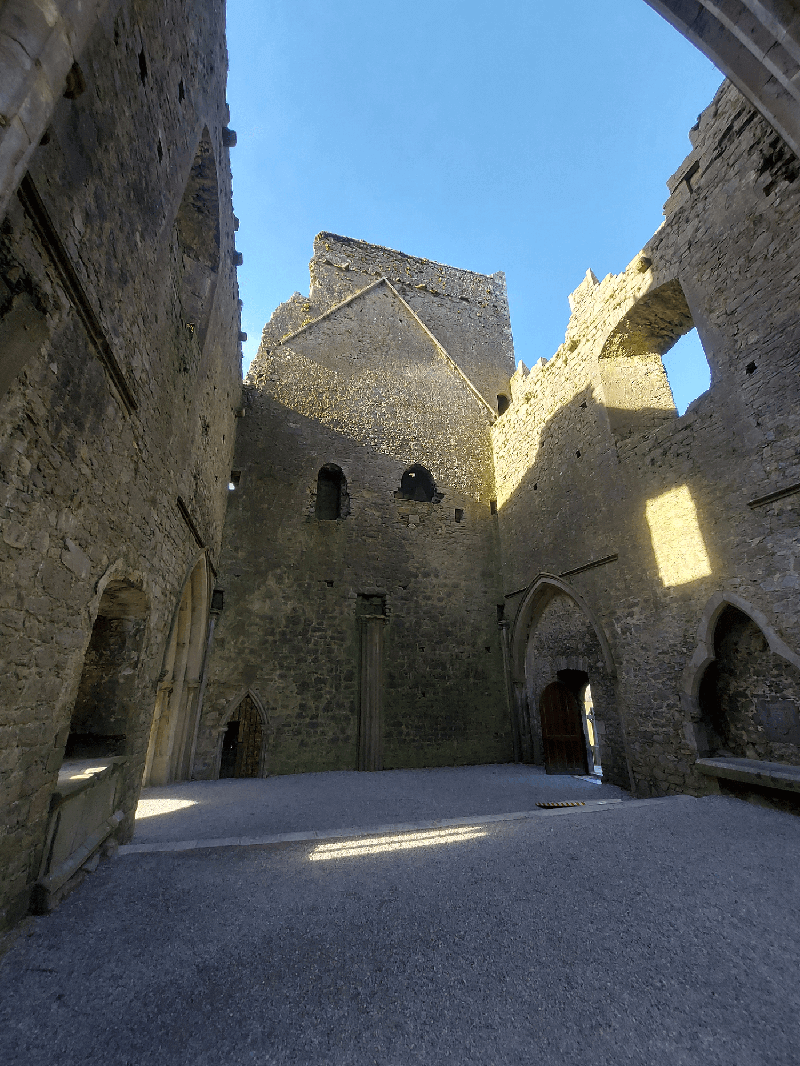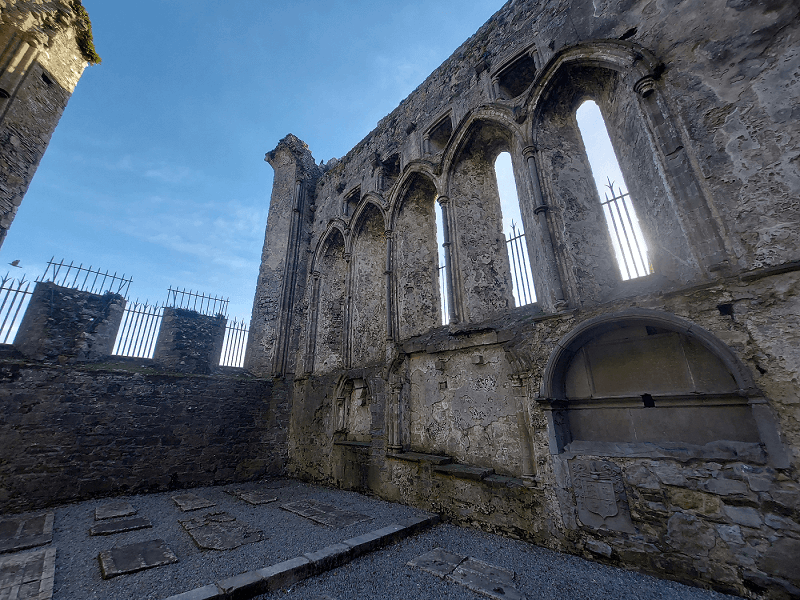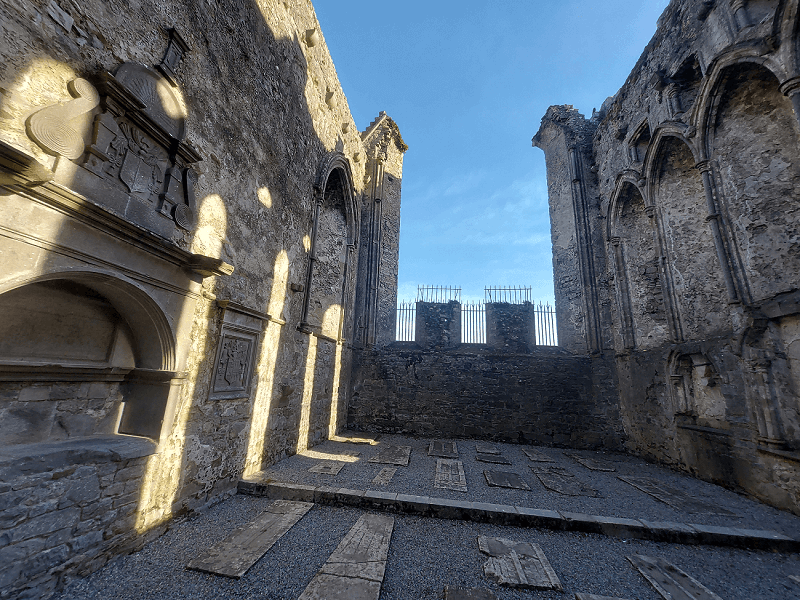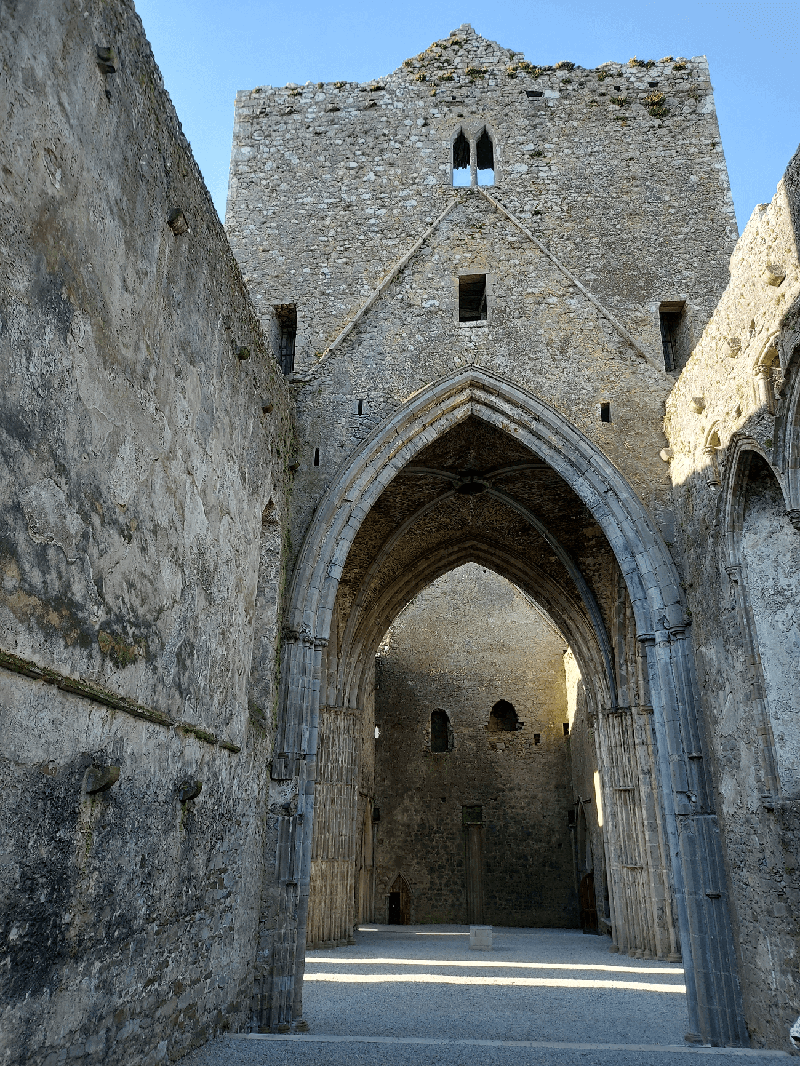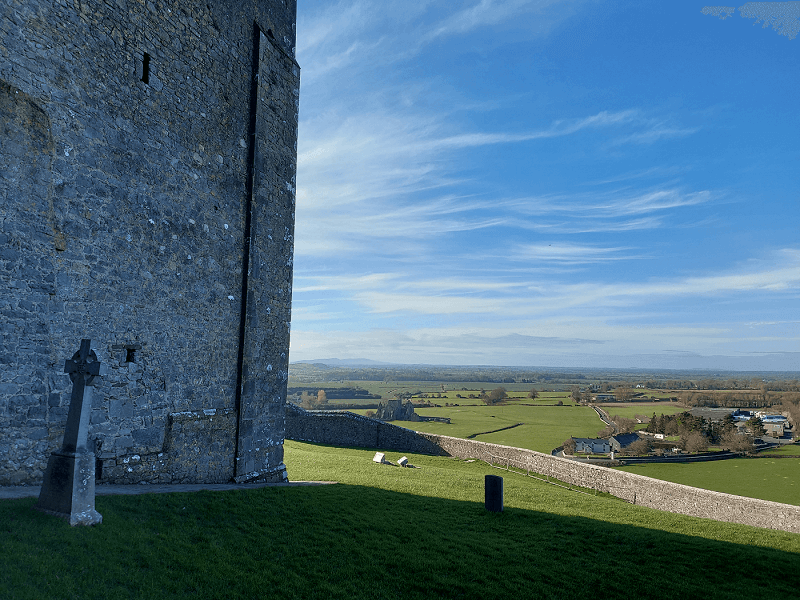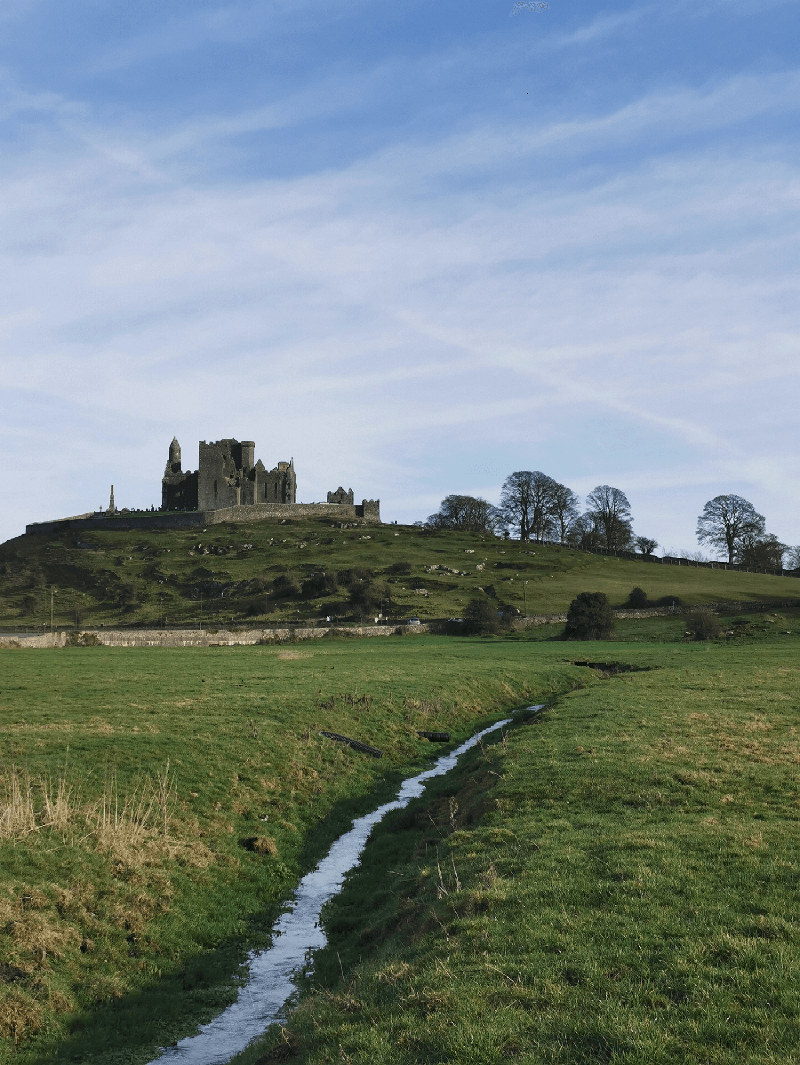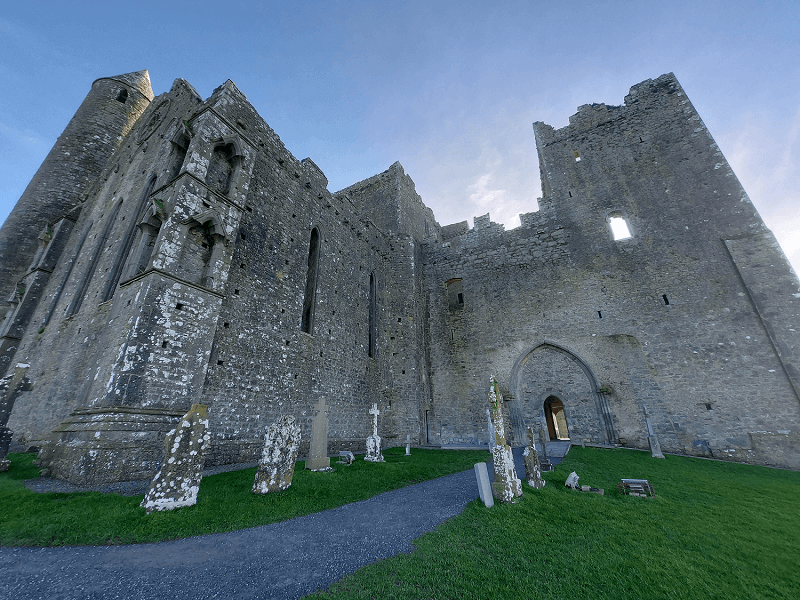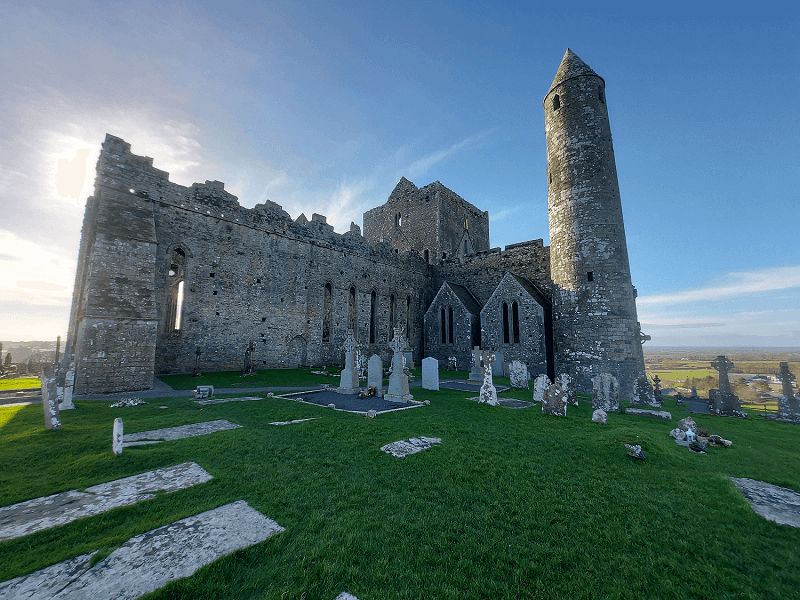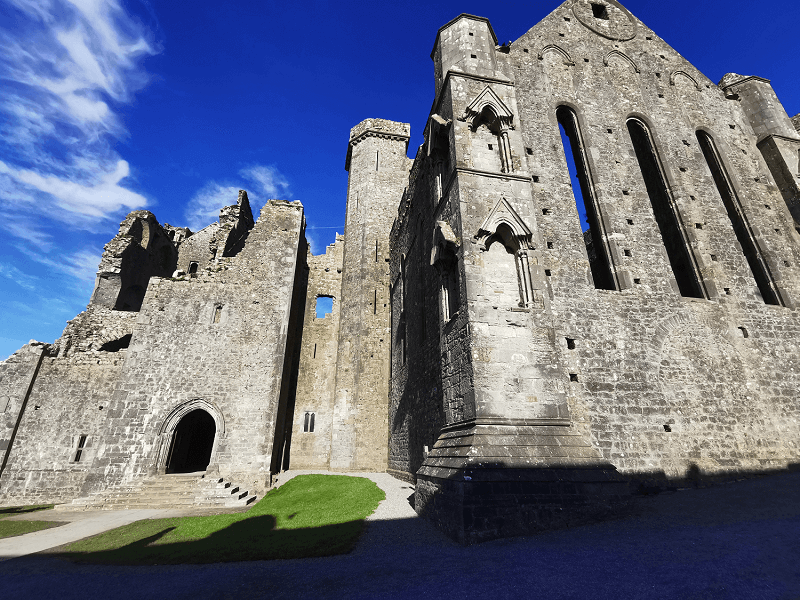History
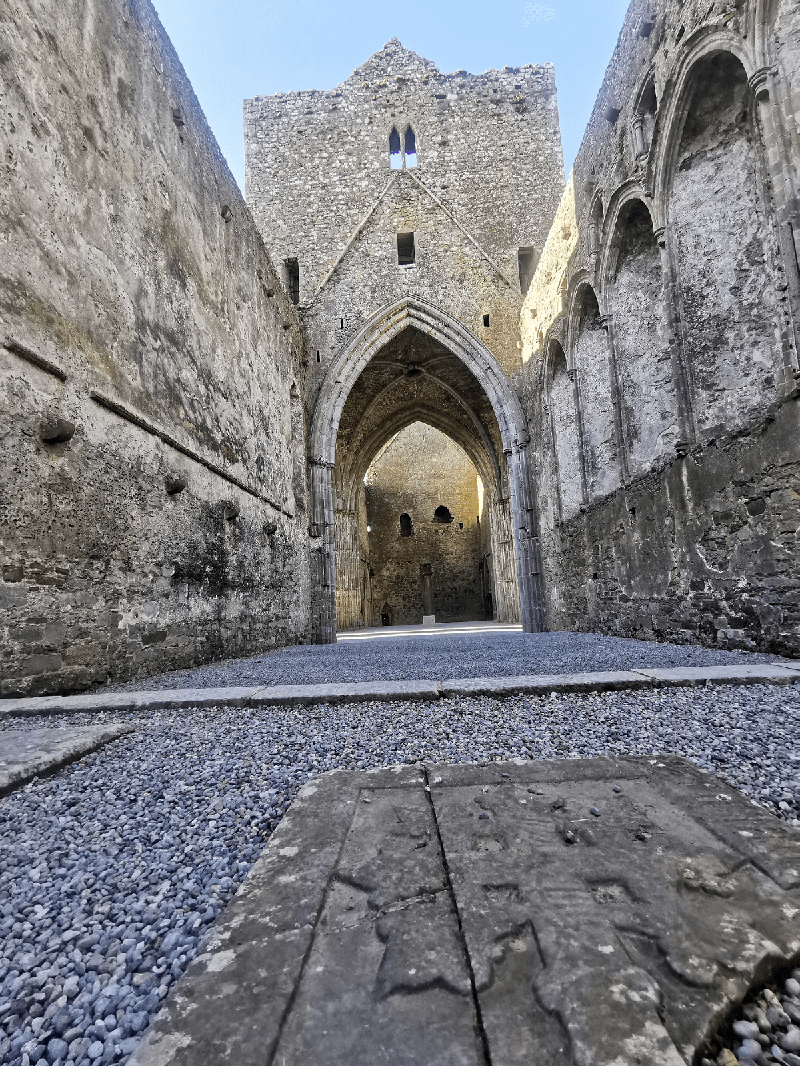
Is this just a castle? Rock of Cashel is much more than that. Both ecclesiastical and political powers enriched this complex to the magnificence we can admire today. It is probably one of the most iconic medieval constructions in the country and deservedly it has nothing to envy to other representative sites across Europe from the same period, thanks to its medieval architecture and the outstanding collections of Celtic art [1], where history and legends get mixed together contributing to the glamor of this place.
Originally known with the Irish name of Carraig Phádraig, meaning Saint Patrick’s Rock, and sometimes also called Cashel of the Kings for reasons that will be soon clarified [2 5], the Rock of Cashel takes its name from the village of Cashel (in Irish, Caiseal, meaning 'stone ringfort’), in County Tipperary, where it is located [2, 6].
The rock of Cashel can be spotted from far, as it sits on a rocky outcrop of limestone in County Tipperary [4, 5, 7, 8].
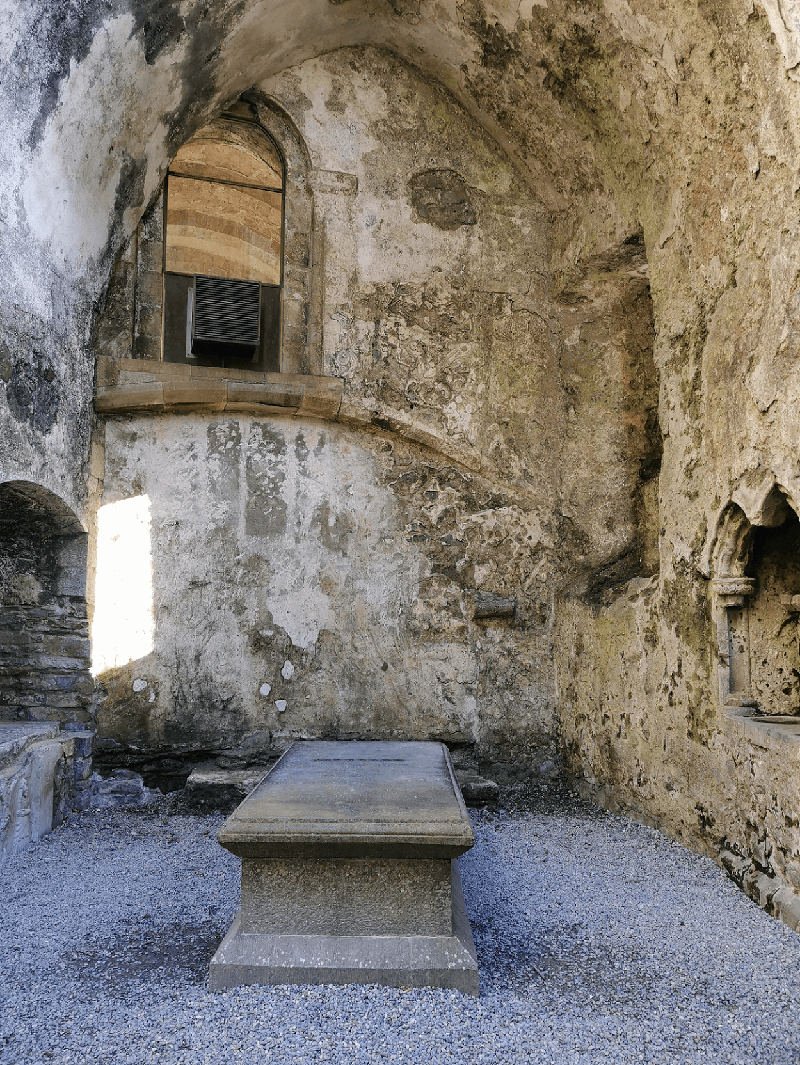 Let’s now dive into the history and the myths and unleash our immagination. Between the late 4th and early 5th century, Conall Corc, descendant of Eogan Mor, founded the Munster kingship at Cashel [6, 9], therefore the rock began to be the Seat of the High Kings of Munster [4, 10]. Their dinasty, also known as Eoganacht, reigned over Cashel and Munster until the 10th century [7]. It was probably during the 5th century, when Christianity started spreading over the Munster provence, that the Eoganacht got Christianised [7]. How that happened is a matter of dibates. The most popular story tells that Saint Patrick came to Cashel to baptise King Oengus (or Aenghus, or Aengus) [3, 6, 9, 10]. During the ritual, Saint Patrick inadvertently dropped his sharp crosier and, without realising of anything, pierced the king’s foot, who believed that it was part of the ceremony, therefore suffered without complaining [6, 9]. If that was true we will not know. For sure we know that the Eoganacht and the rock of Cashel truly represent Ireland’s early Christian heritage, as many of the kings of Munster were Christians since those early days [9, 10].
Let’s now dive into the history and the myths and unleash our immagination. Between the late 4th and early 5th century, Conall Corc, descendant of Eogan Mor, founded the Munster kingship at Cashel [6, 9], therefore the rock began to be the Seat of the High Kings of Munster [4, 10]. Their dinasty, also known as Eoganacht, reigned over Cashel and Munster until the 10th century [7]. It was probably during the 5th century, when Christianity started spreading over the Munster provence, that the Eoganacht got Christianised [7]. How that happened is a matter of dibates. The most popular story tells that Saint Patrick came to Cashel to baptise King Oengus (or Aenghus, or Aengus) [3, 6, 9, 10]. During the ritual, Saint Patrick inadvertently dropped his sharp crosier and, without realising of anything, pierced the king’s foot, who believed that it was part of the ceremony, therefore suffered without complaining [6, 9]. If that was true we will not know. For sure we know that the Eoganacht and the rock of Cashel truly represent Ireland’s early Christian heritage, as many of the kings of Munster were Christians since those early days [9, 10].
Before moving on, there is another tale to be mentioned and that also sees Saint Patrick as protagonist. According to this story, the Rock of Cashel is a piece of the Devil’s Bit Mountain, located about 20 miles north of Cashel [8]. The devil was hiding in a cave on the Devil’s Bit Mountain, till a dramatic battle was erupted by Saint Patrick [8]. Here the legend has a fork and two different endings are possible. Perhaps the strength used by Saint Patrick to evict the devil was so vigorous that a piece of the mountain flew to Cashel, forming the rock. The other final says that the devil, after realizing that could not face Saint Patrick’s force, bit the mountain to make a hole from which he could runaway and the piece of mountain that was blown away landed in Cashel [1, 2, 8, 10].
The Eoganacht power start decreasing from the 10th century [9]. Two events caused this decline. First, King Cormac mac Cuilennain’s was defeated by the King of Tara during the Battle of Ballaghmoon in Kildare in 908 [9]. Second, the increasing influence of the Vikings in the Munster provence weaknessed the Eoganacht, till they were eventually replaced by the Dal Cais, originally from Clare [9]. One of the most important members of the Dal Cais dinasty was Brian Boru, crowned King of Munster at the Rock of Cashel in 978 [6, 7, 9], before becoming the High King of Ireland, who died in the Battle of Clontarf in 1014, fighting against the Vikings [4, 9].
The history of the Rock changed its direction when Brian Boru’s great grandson, Muircheartach Ua Briain, rose to power till becoming King of Munster and, subsequently, when he decided to donate the site to the church in 1101, as “a gift to religion that no king had ever given before him” [2, 4, 5, 8, 9, 10]. The reason behind this donation was more political than religious [9]. In fact, the 12th century was a period of social transformation and reforms, that saw the church acquiring more power. With this gift, Muircheartach mostly intended to secure his political power [9], preventing the Eoganacht from claiming their ancient royal seat back [4]. This is also demonstrated by the cruelty used by Muircheartach’s army against churches and clergy in Ulster, when he unsuccessfully tried to subdue this provence [9].
 However, starting from this moment, the Rock of Cashel became one of the most significant centres of ecclesiastical power in the country [7], growing till taking the marvellous shape that we can admire today [9]. For example, it is common opinion that the 28m tall round tower made from limestone and sandstone was built in this period [7, 9]. The tower is probably the rock’s oldest surviving building [10].
However, starting from this moment, the Rock of Cashel became one of the most significant centres of ecclesiastical power in the country [7], growing till taking the marvellous shape that we can admire today [9]. For example, it is common opinion that the 28m tall round tower made from limestone and sandstone was built in this period [7, 9]. The tower is probably the rock’s oldest surviving building [10].
After Muircheartach’s death in 1119, the power of the O’Brien house (as they were called in memory of their famous ancestor, Brien Boru) diminished and the Eoganacht managed to restore their authority at Cashel, leaded by the McCarthy family, who were even able to claim their ancestral home at Cashel back [9]. This is proven by the construction in 1127 of the romanesque Cormac’s Chapel, commissioned by Cormac McCarthy, that got consecrated in 1134 [2, 4, 9].
The artistic value of the chapel is enriched by the presence of the only surviving romanesque frescoes in Ireland and other remarkable decorative ornaments, like the tympanum depicting a centaur hunting a lion [7]. The chapel’s structure includes vaulted ceilings and wide arches, inspired by the contemporary European architecture, with the addition of unique native elements [2]. The chapel also contains one well preserved fresco from this time period [2]. Moreover, a sarcophagus can be found in the chapel that, according to a legend, contains the remains of King Cormac’s brother Tadhg [10].
During the Anglo Norman invasion of Ireland (1169-1175), Domhnall Mor O’Brien, King of Thomond, met Henry II and recognised his power in Ireland [9]. A synod was then called in 1172 in Cashel by Henry II, with the support of the Pope, Alexander III, to which several Irish archbishops and bishops participated, with the intention to align the Irish Church practises with those of England [9].
Several buildings were added to the Rock of Cashel and modified in the following years. Saint Patrick’s Cathedral was built in the 13th century, perhaps with the intention to replace an earlier Cathedral [9]. During the 15th century, the Cathedral was largely altered, by adding a bell tower and by attaching a residential tower to its western side. Moreover, the Hall of the Vicar’s Choral, hosting the 8-man choir singing in the Cathedral, was added in these years [9].
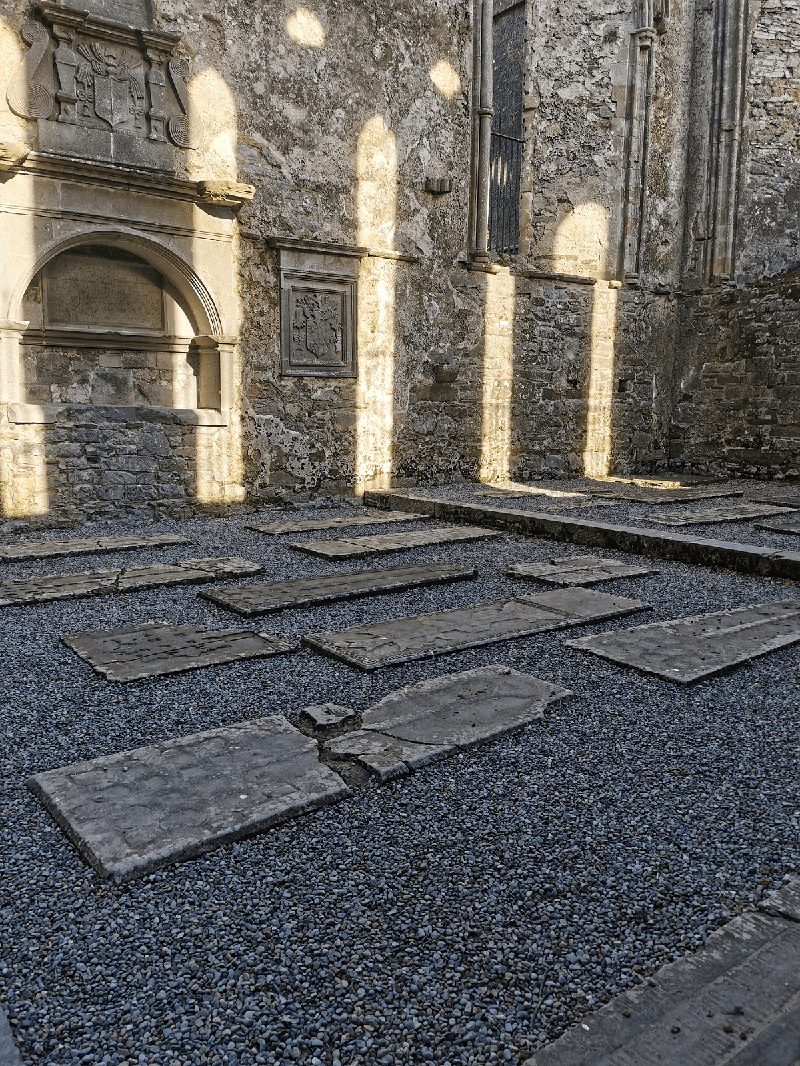 After the Anglican Church was founded by King Henry VIII, in 1561 the Cathedral became Anglican [9].
After the Anglican Church was founded by King Henry VIII, in 1561 the Cathedral became Anglican [9].
During the Irish Confederate Wars (Eleven Years’ War), in 1647, the Cathedral was sacked by English Parliamentarian troops [2, 9]. First, Cashel was reconquered by Catholic forces and many English settlers were killed [9]. Then, in 1647, an English army leaded by Murrough O'Brien, Baron Inchiquin, descendant of Brian Buru, approached Cashel, with the intention to restore the Anglican domain over Cashel [9]. It is estimated that around a thousand people, who tried to find a shelter in the Cathedral have been murdered by Inchiquin’s troops, along with clergy and Irish Confederate troops [2, 9]. It is also told that the Cathedral was looted and many religious artefacts got destroyed, including paintings of remarkable value [2, 9]. Later on in his life, under different circumstances, Baron Inchiquin converted to Catholicism, the faith of his ancestors [9].
Other news about the Cathedral come from the 1730s, when Arthur Price, the Anglican Archbishop of Cashel, decided to remove the roof. In any case, in the following years, repair works were accomplished till the site was eventually abandoned in the late 1740s, slowly falling into ruin [9].
 Starting from 1869, the site became Ireland’s first national monument and was taken over by the state [9]. Nowadays, the site is under the care of the Office of Public Works [9].
Starting from 1869, the site became Ireland’s first national monument and was taken over by the state [9]. Nowadays, the site is under the care of the Office of Public Works [9].
The buildings are surrounded by a graveyard, where the Scully monument rises, added in 1867 [1, 9]. It was initially a high cross but was struck by lightening in 1976 [9]. The remains of the top of the cross now lie at the base of the cross [1].
At the site’s entrance, visitors will find the replica of a 12th-century High Cross of Saint Patrick that sits at the Rock. It is known as Larin cross [5], whose original is stored in the medieval hall of the Vicars’ Choral, protected from the adverse weather conditions [4, 6]. Originally, the cross was supported by two stone arms, of which only one remains [5]. Two scenes are carved on the two sides of the cross: one represents Christ wearing a long robe, the other face has a bishop carrying a crosier, that most likely is Saint Patrick standing on an animal’s head [5, 6]. Perhaps, the depiction of Christ is inspired to the Volto Santo wooden crucifix from Lucca in Italy, proving the strong European influences [4].
References
- [1] Irish Tourism, Rock of Cashel
- [2] Wikipedia, Rock of Cashel
- [3] Cashel.ie, Rock of Cashel
- [4] Tuatha, The Rock of Cashel
- [5] Megalithic Ireland, The Rock of Cashel
- [6] XYUandBEYOND, The Magnificent Rock of Cashel Ireland
- [7] Heritage Ireland, Rock of Cashel
- [8] The Irish Road Trip, A Guide To Visiting The Rock Of Cashel
- [9] The Standing Stone, The Rock of Cashel
- [10] www.ireland.com, Rock of Cashel
Other useful links
- DiscoverIreland, Rock of Cashel
- My Real Ireland, What is the Rock of Cashel
- All Around Ireland, Third Time Lucky at the Rock of Cashel
- Travel? Yes please!, The Rock of Cashel
- Irish History, The Rock of Cashel: A Glorious History
- Laidback Trip, How to Visit the Rock of Cashel
- Documenting Ireland, The Rock of Cashel
- Lonely Planet, Rock of Cashel
- Wilderness Ireland, The Rock of Cashel
- Ireland Highlights, Rock of Cashel
- South East Ireland, Rock of Cashel
- Ask About Ireland, The Rock of Cashel
- One Trip at a Time, Exploring the Rock of Cashel
- Hennessy & Furlong, THE ROCK OF CASHEL – HOME OF CELTIC KINGS
- The Journal, How to do the Rock of Cashel like a pro
- enjoy-irish-culture, Rock of Cashel
- Ireland Before You Die, 10 facts about the Rock of Cashel
- Irish Expressions, The Rock of Cashel
- Wikipedia, Anglo-Norman invasion of Ireland
- Wikipedia, Brian Boru
- Wikipedia, Irish Confederate Wars
